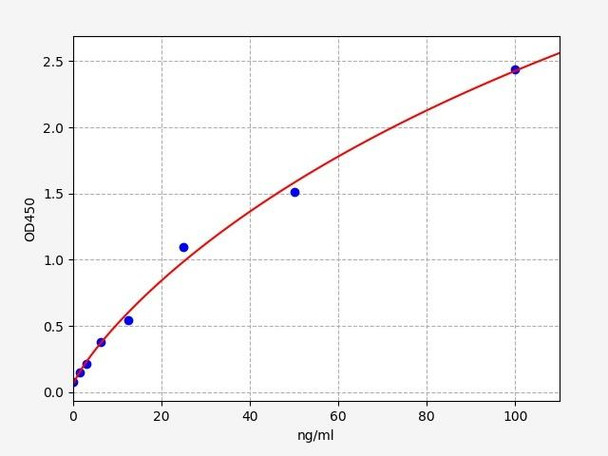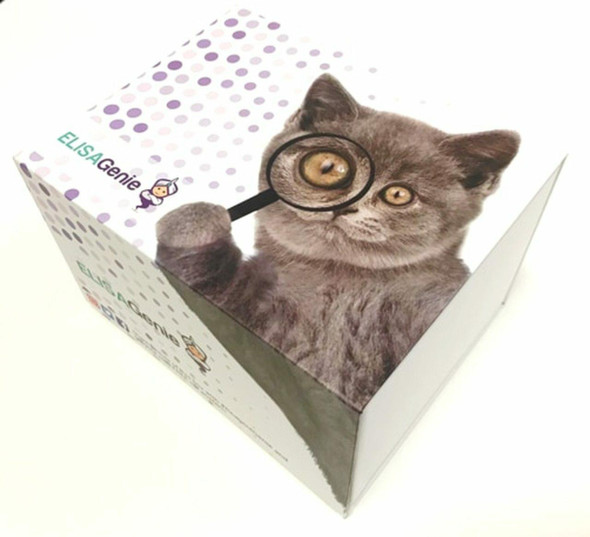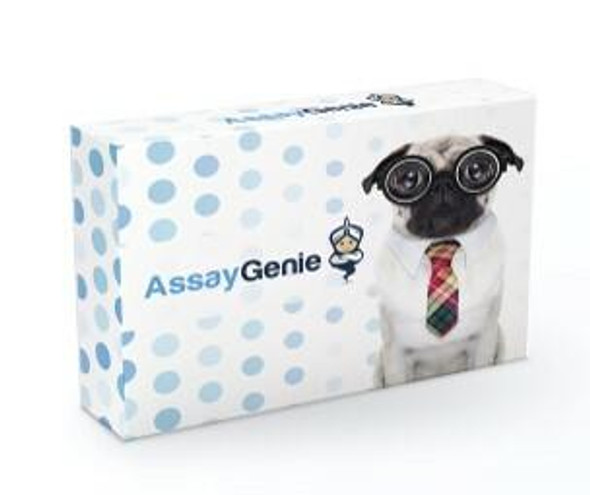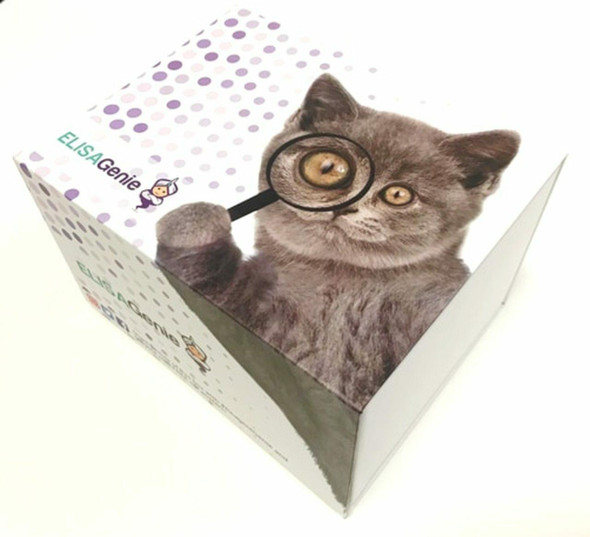Human Tenascin X / TNXB ELISA Kit (HUFI02911)
- SKU:
- HUFI02911
- Product Type:
- ELISA Kit
- Size:
- 96 Assays
- Uniprot:
- P22105
- Sensitivity:
- 0.938ng/ml
- Range:
- 1.563-100ng/ml
- ELISA Type:
- Sandwich
- Synonyms:
- TNX, HXBL, TNXB, TNXBS, XB, XB-S, Hexabrachion-like protein, HXBL, tenascin XB, tenascin XB2, TNXB1growth-inhibiting protein 45, TNXB2tenascin XB1, TNXBSTNXTENX, XBS, XBTN-X
- Reactivity:
- Human
- Research Area:
- Cell Biology
Description
Human Tenascin X/TNXB ELISA Kit
The Human Tenascin-X (TNXB) ELISA Kit is a highly sensitive and specific assay designed for the accurate detection of Tenascin-X levels in human biological samples such as serum, plasma, and cell culture supernatants. Tenascin-X is a key extracellular matrix protein involved in tissue development and repair, making it a valuable marker for studying various physiological and pathological processes.This ELISA kit provides researchers with a reliable and reproducible tool for quantitative analysis of Tenascin-X levels, allowing for precise measurements and comparisons across different samples.
Its easy-to-use format and quick results turnaround make it suitable for a wide range of research applications in fields such as cell biology, cancer research, and tissue engineering.By accurately measuring Tenascin-X levels, researchers can gain valuable insights into its role in conditions such as connective tissue disorders, fibrosis, and wound healing. This kit offers a convenient solution for studying Tenascin-X biology and potential therapeutic targets, ultimately advancing our understanding of this important protein and its implications in disease.
| Product Name: | Human Tenascin X / TNXB ELISA Kit |
| Product Code: | HUFI02911 |
| Size: | 96 Assays |
| Alias: | TNX, HXBL, TNXB, TNXBS, XB, XB-S, Hexabrachion-like protein, HXBL, tenascin XB, tenascin XB2, TNXB1growth-inhibiting protein 45, TNXB2tenascin XB1, TNXBSTNXTENX, XBS, XBTN-X |
| Detection method: | Sandwich ELISA, Double Antibody |
| Application: | This immunoassay kit allows for the in vitro quantitative determination of Human TNX concentrations in serum plasma and other biological fluids. |
| Sensitivity: | 0.938ng/ml |
| Range: | 1.563-100ng/ml |
| Storage: | 4°C for 6 months |
| Note: | For Research Use Only |
| Recovery: | Matrices listed below were spiked with certain level of Human TNX and the recovery rates were calculated by comparing the measured value to the expected amount of Human TNX in samples. | ||||||||||||||||
| |||||||||||||||||
| Linearity: | The linearity of the kit was assayed by testing samples spiked with appropriate concentration of Human TNX and their serial dilutions. The results were demonstrated by the percentage of calculated concentration to the expected. | ||||||||||||||||
| |||||||||||||||||
| CV(%): | Intra-Assay: CV<8% Inter-Assay: CV<10% |
| Component | Quantity | Storage |
| ELISA Microplate (Dismountable) | 8×12 strips | 4°C for 6 months |
| Lyophilized Standard | 2 | 4°C/-20°C |
| Sample/Standard Dilution Buffer | 20ml | 4°C |
| Biotin-labeled Antibody(Concentrated) | 120ul | 4°C (Protect from light) |
| Antibody Dilution Buffer | 10ml | 4°C |
| HRP-Streptavidin Conjugate(SABC) | 120ul | 4°C (Protect from light) |
| SABC Dilution Buffer | 10ml | 4°C |
| TMB Substrate | 10ml | 4°C (Protect from light) |
| Stop Solution | 10ml | 4°C |
| Wash Buffer(25X) | 30ml | 4°C |
| Plate Sealer | 5 | - |
Other materials and equipment required:
- Microplate reader with 450 nm wavelength filter
- Multichannel Pipette, Pipette, microcentrifuge tubes and disposable pipette tips
- Incubator
- Deionized or distilled water
- Absorbent paper
- Buffer resevoir
| Uniprot | P22105 |
| UniProt Protein Function: | TNXB: Appears to mediate interactions between cells and the extracellular matrix. Substrate-adhesion molecule that appears to inhibit cell migration. Accelerates collagen fibril formation. May play a role in supporting the growth of epithelial tumors. Defects in TNXB are the cause of tenascin-X deficiency (TNXD). TNXD leads to an Ehlers-Danlos-like syndrome characterized by hyperextensible skin, hypermobile joints, and tissue fragility. Tenascin-X-deficient patients, however, lack atrophic scars, a major diagnostic criteria for classic Ehlers- Danlos. Delayed wound healing, which is also common in classic EDS, is only present in a subset of patients. Belongs to the tenascin family. 3 isoforms of the human protein are produced by alternative splicing. |
| UniProt Protein Details: | Protein type:Secreted; Extracellular matrix; Secreted, signal peptide; Motility/polarity/chemotaxis Chromosomal Location of Human Ortholog: 6p21.3 Cellular Component: extracellular matrix; extracellular space; proteinaceous extracellular matrix; fibrillar collagen; intracellular Molecular Function:collagen binding; integrin binding; heparin binding Biological Process: elastic fiber assembly; cell-cell adhesion; collagen fibril organization; triacylglycerol metabolic process; collagen metabolic process; cell-matrix adhesion; regulation of JNK activity; fibril organization and biogenesis; cell adhesion; fatty acid metabolic process; actin cytoskeleton organization and biogenesis Disease: Ehlers-danlos-like Syndrome Due To Tenascin-x Deficiency; Vesicoureteral Reflux 8 |
| NCBI Summary: | This gene encodes a member of the tenascin family of extracellular matrix glycoproteins. The tenascins have anti-adhesive effects, as opposed to fibronectin which is adhesive. This protein is thought to function in matrix maturation during wound healing, and its deficiency has been associated with the connective tissue disorder Ehlers-Danlos syndrome. This gene localizes to the major histocompatibility complex (MHC) class III region on chromosome 6. It is one of four genes in this cluster which have been duplicated. The duplicated copy of this gene is incomplete and is a pseudogene which is transcribed but does not encode a protein. The structure of this gene is unusual in that it overlaps the CREBL1 and CYP21A2 genes at its 5' and 3' ends, respectively. Multiple transcript variants encoding different isoforms have been found for this gene. [provided by RefSeq, Jul 2008] |
| UniProt Code: | P22105 |
| NCBI GenInfo Identifier: | 290457668 |
| NCBI Gene ID: | 7148 |
| NCBI Accession: | P22105.3 |
| UniProt Related Accession: | P22105 |
| Molecular Weight: | |
| NCBI Full Name: | Tenascin-X |
| NCBI Synonym Full Names: | tenascin XB |
| NCBI Official Symbol: | TNXBÂ Â |
| NCBI Official Synonym Symbols: | XB; TNX; XBS; EDS3; HXBL; TENX; TN-X; VUR8; TNXB1; TNXB2; TNXBS; EDSCLL; EDSCLL1Â Â |
| NCBI Protein Information: | tenascin-X |
| UniProt Protein Name: | Tenascin-X |
| UniProt Synonym Protein Names: | Hexabrachion-like protein |
| Protein Family: | Tenascin |
| UniProt Gene Name: | TNXBÂ Â |
| UniProt Entry Name: | TENX_HUMAN |
*Note: Protocols are specific to each batch/lot. For the correct instructions please follow the protocol included in your kit.
Before adding to wells, equilibrate the SABC working solution and TMB substrate for at least 30 min at 37°C. When diluting samples and reagents, they must be mixed completely and evenly. It is recommended to plot a standard curve for each test.
| Step | Protocol |
| 1. | Set standard, test sample and control (zero) wells on the pre-coated plate respectively, and then, record their positions. It is recommended to measure each standard and sample in duplicate. Wash plate 2 times before adding standard, sample and control (zero) wells! |
| 2. | Aliquot 0.1ml standard solutions into the standard wells. |
| 3. | Add 0.1 ml of Sample / Standard dilution buffer into the control (zero) well. |
| 4. | Add 0.1 ml of properly diluted sample ( Human serum, plasma, tissue homogenates and other biological fluids.) into test sample wells. |
| 5. | Seal the plate with a cover and incubate at 37 °C for 90 min. |
| 6. | Remove the cover and discard the plate content, clap the plate on the absorbent filter papers or other absorbent material. Do NOT let the wells completely dry at any time. Wash plate X2. |
| 7. | Add 0.1 ml of Biotin- detection antibody working solution into the above wells (standard, test sample & zero wells). Add the solution at the bottom of each well without touching the side wall. |
| 8. | Seal the plate with a cover and incubate at 37°C for 60 min. |
| 9. | Remove the cover, and wash plate 3 times with Wash buffer. Let wash buffer rest in wells for 1 min between each wash. |
| 10. | Add 0.1 ml of SABC working solution into each well, cover the plate and incubate at 37°C for 30 min. |
| 11. | Remove the cover and wash plate 5 times with Wash buffer, and each time let the wash buffer stay in the wells for 1-2 min. |
| 12. | Add 90 µl of TMB substrate into each well, cover the plate and incubate at 37°C in dark within 10-20 min. (Note: This incubation time is for reference use only, the optimal time should be determined by end user.) And the shades of blue can be seen in the first 3-4 wells (with most concentrated standard solutions), the other wells show no obvious color. |
| 13. | Add 50 µl of Stop solution into each well and mix thoroughly. The color changes into yellow immediately. |
| 14. | Read the O.D. absorbance at 450 nm in a microplate reader immediately after adding the stop solution. |
When carrying out an ELISA assay it is important to prepare your samples in order to achieve the best possible results. Below we have a list of procedures for the preparation of samples for different sample types.
| Sample Type | Protocol |
| Serum | If using serum separator tubes, allow samples to clot for 30 minutes at room temperature. Centrifuge for 10 minutes at 1,000x g. Collect the serum fraction and assay promptly or aliquot and store the samples at -80°C. Avoid multiple freeze-thaw cycles. If serum separator tubes are not being used, allow samples to clot overnight at 2-8°C. Centrifuge for 10 minutes at 1,000x g. Remove serum and assay promptly or aliquot and store the samples at -80°C. Avoid multiple freeze-thaw cycles. |
| Plasma | Collect plasma using EDTA or heparin as an anticoagulant. Centrifuge samples at 4°C for 15 mins at 1000 × g within 30 mins of collection. Collect the plasma fraction and assay promptly or aliquot and store the samples at -80°C. Avoid multiple freeze-thaw cycles. Note: Over haemolysed samples are not suitable for use with this kit. |
| Urine & Cerebrospinal Fluid | Collect the urine (mid-stream) in a sterile container, centrifuge for 20 mins at 2000-3000 rpm. Remove supernatant and assay immediately. If any precipitation is detected, repeat the centrifugation step. A similar protocol can be used for cerebrospinal fluid. |
| Cell culture supernatant | Collect the cell culture media by pipette, followed by centrifugation at 4°C for 20 mins at 1500 rpm. Collect the clear supernatant and assay immediately. |
| Cell lysates | Solubilize cells in lysis buffer and allow to sit on ice for 30 minutes. Centrifuge tubes at 14,000 x g for 5 minutes to remove insoluble material. Aliquot the supernatant into a new tube and discard the remaining whole cell extract. Quantify total protein concentration using a total protein assay. Assay immediately or aliquot and store at ≤ -20 °C. |
| Tissue homogenates | The preparation of tissue homogenates will vary depending upon tissue type. Rinse tissue with 1X PBS to remove excess blood & homogenize in 20ml of 1X PBS (including protease inhibitors) and store overnight at ≤ -20°C. Two freeze-thaw cycles are required to break the cell membranes. To further disrupt the cell membranes you can sonicate the samples. Centrifuge homogenates for 5 mins at 5000xg. Remove the supernatant and assay immediately or aliquot and store at -20°C or -80°C. |
| Tissue lysates | Rinse tissue with PBS, cut into 1-2 mm pieces, and homogenize with a tissue homogenizer in PBS. Add an equal volume of RIPA buffer containing protease inhibitors and lyse tissues at room temperature for 30 minutes with gentle agitation. Centrifuge to remove debris. Quantify total protein concentration using a total protein assay. Assay immediately or aliquot and store at ≤ -20 °C. |
| Breast Milk | Collect milk samples and centrifuge at 10,000 x g for 60 min at 4°C. Aliquot the supernatant and assay. For long term use, store samples at -80°C. Minimize freeze/thaw cycles. |






